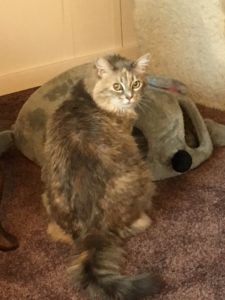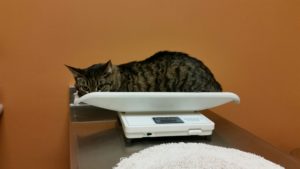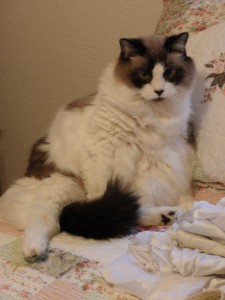 We’ve all seen the drawing (or photograph) of a clearly obese cat with the caption: “I’m not fat, I’m fluffy.” And it’s that fur that can sometimes be a hindrance in determining whether your cat’s putting on weight or even losing weight–both which can be red flags in determining her level of health.
We’ve all seen the drawing (or photograph) of a clearly obese cat with the caption: “I’m not fat, I’m fluffy.” And it’s that fur that can sometimes be a hindrance in determining whether your cat’s putting on weight or even losing weight–both which can be red flags in determining her level of health.
How do you know when your cat’s weight is creeping up to a dangerous level? Yes dangerous! One report says that just two or three extra pounds on a cat can be equivalent to forty pounds for a human. And we all know that this much extra weight can put us at risk for arthritis, diabetes, heart and liver issues, bladder stones and skin conditions. It’s the same for your cat.
Although a cat’s ideal weight varies depending on the breed, lifestyle, gender, and bone structure, the average cat weights around 7 to 11 pounds.
While I keep a close eye on our cats’ weight and eating habits, I depend on my veterinarian to tell me when we should cut down on food for our cats and engage them in more exercise, etc. However, we’ve been to see the vet recently and both of our cats are over the average weight. Lily is in the twelve pound range and Sophie hit fourteen pounds this trip. So I guess our vet considers this normal for our cats.
to tell me when we should cut down on food for our cats and engage them in more exercise, etc. However, we’ve been to see the vet recently and both of our cats are over the average weight. Lily is in the twelve pound range and Sophie hit fourteen pounds this trip. So I guess our vet considers this normal for our cats.
Here’s one way to judge whether your cat is overweight. View her from the top as she’s standing on all fours. She should have a waistline and you should be able to feel her ribs but not see them. How do you see ribs through all that fur?

Max
The key to putting your cat on a diet is less access to food and maybe a different kind of food. Some professionals suggest lacing new food that the cat isn’t excited about with beef or chicken broth. But others warn that these pre-packaged products can contain garlic and onions—a big no-no for cats. So if you want to do this, consider reading labels and/or make your own broth.
Never put a cat on a crash diet or replace her food abruptly. Not only do you run the risk of being clawed to death in your sleep (if your cat lives for food like our Lily does), this is dangerous to her health.
Here are two sites I found useful and informative on this topic. If you notice that your cat is moving more slowly than usual, playing less often, and looks fluffier (fatter) than usual, visit your veterinarian. If he or she agrees and her exam doesn’t reveal an underlying cause that needs treatment, let them help you to put your cat on a healthy eating plan and a good exercise regime and do your best to follow it.
I like those feeding balls that came out a few years ago–the kibbles come out one or two at a time when the ball is rolled in a certain way. So the cat has to work for his food. It keeps him busy, alert, active, and he’s probably eating less.
https://www.sciencedaily.com/releases/2018/01/180124131708.htm
http://www.animalplanet.com/pets/healthy-pets/how-to-put-your-cat-on-a-diet/





